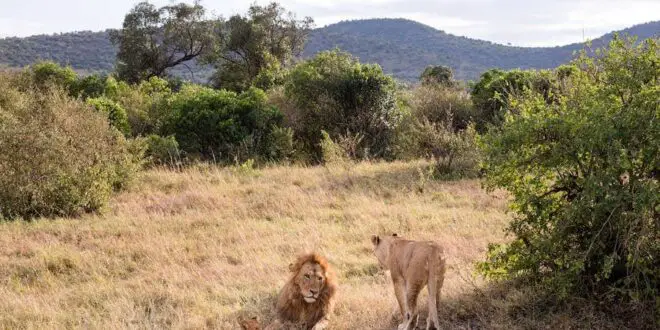You might have tried to compare mountain lion size vs human size. Mountain lions are mighty cats and will attack when they feel threatened.
They can slay large animals like elk and moose due to their size, but they are also excellent hunters of lesser prey.
The mountain lion is a large feline, whether you call it a puma, cougar, or phantom cat. These cunning animals are native to North and South America but widespread throughout the Western Hemisphere.
Due to their size and aggression, they are among the top predators in their region. They are larger than both jaguars and wolves.
Still, you need to be made aware of their actual size. A mountain lion measure guide is helpful in this situation. Let’s dive in.
Mountain Lions Explained
The scientific name for mountain cats is Puma concolor, which translates to “cat of one color.” It is typical for their back and sides to be tawny to pale gold.
Their breast and bottom are white, while their ear backs and tail tips are black. Males and females have varying heights and weights.
Males are approximately a third larger than females. Adult males can exceed eight feet in height and weigh between 135 and 175 pounds. Adults can grow up to seven feet in length and weigh between 90 and 105 pounds.
It is simple to distinguish mountain lions from bobcats, lynxes, and other feral cats. Lions are significantly larger than lynx and bobcats, except for their young. Their tails are incredibly lengthy and account for nearly one-third of their body length.
The cat’s diet consists of flesh, and the most common prey is deer and elk. The lions’ attack involves bites that break the vertebrae or enter the skull or “choking” bites that squeeze the windpipe.
They consume the body and cover the bones with leaves, twigs, or pine branches. After digestion, the lion will return to finish their prey once again.
This process continues until nearly all of the edible portions have been consumed. Lions have been seen hunting beavers, rabbits, bighorn sheep, coyotes, venison, turkeys, and even porcupines.
Domestic animals like livestock and pets are also susceptible to attacks. Lions are most active at dawn and dusk when hunting deer and elk. It may be challenging to locate a mountain cat if you do not know what to search for.
A lion’s clearest “sign” is its traces in fresh snow or porous ground. Feces is a less apparent but equally revealing sign to be alert.
Mountain Lion Size
Young mountain lions are referred to as cubs. They are approximately four times the size of a domestic neonate when they are born.
They are approximately 12 inches long and weigh about a pound when born. In addition, their dense, luxurious fur makes them appear larger than they are.
A mountain lion’s fur is predominantly brown, with dense fur on the back and paler fur on the belly. When mountain lions inhabit humid, damp environments, their fur becomes darker and more rusty brown.
Their hair is denser, longer, and nearly silvery gray in frigid climates. Males weigh 40 to 60 percent more than women as adults.
Scientists refer to mountain lions as small cats because, unlike other cats, they do not growl but instead purrs. Its physique and demeanor resemble those of a cheetah. Both cats would rather flee than combat and attempt to avoid people.
The weight of a mountain cat can exceed 200 pounds. Their weight varies greatly depending on their gender, age, and location. They may weigh as little as 64 or as much as 220 pounds. To attack or defend themselves, their larger size gives them an advantage.
These animals rarely exceed 3 feet in height at the shoulder. Their bodies can reach approximately 5 feet in length, and their tails can range from 23 to 33 inches.
Mountain lions can reach a maximum length of 7.7 feet and a maximum weight of 220 pounds. A mountain cat’s pelt will also contain a few small black patches. The animal’s snout, the ends of its ears, and its tail will all bear these markings.
To help them blend in, young ones have more black spots than adults. Cubs have blue eyes, while adults have green-brown or yellow eyes.
Mountain Lion Size vs Human Size
The mountain lion is a compelling animal. It is roughly the size of a human but slightly lighter, average.
Depending on their height, mountain lions typically approach most humans and graze them up to the knee or mid-thigh.
They are three feet tall at the shoulders and not amusing at all. Regarding weight, a large mountain cat may be too much for someone. This cat can weigh between 60 and 220 pounds, comparable to a laundry machine.
Mountain lions need to match up with people in matters concerning height. A mountain lion can reach a total length of 8 feet, including its tail.
Most individuals stand between 5 and 6 feet tall. This implies that most individuals would feel insignificant when standing next to a mountain lion from its head to its tail.
Do Mountain Lions Attack Humans?
They do not typically view humans as prey but occasionally attack humans. They are more likely to kill, particularly when they are startled.
When encountering humans, they typically flee unless they are confined or a mother is safeguarding her young. Do not flee or turn around if you encounter a mountain cat. Make yourself larger and louder to frighten away the mountain cat.
The mountain lion is the most prevalent cat in the Americas, from Canada to Argentina. They inhabit semiarid, hilly, subtropical, tropical forests and lakes, and semiarid and hilly, semiarid, and hilly terrain.
Mountain lions are most prevalent in regions rich in vegetation, boulders, and animals. They perform activities throughout the year. Mountain lions prefer to avoid humans, but they can and do coexist with humans. They tend to thrive more when there are fewer individuals present.
Similarities Between Mountain Lions and Humans
There are little to no similarities between mountain lions and humans. However, like humans, male mountain lions typically outweigh their females. The males weigh over 150 pounds, while females weigh approximately 120 pounds.
Differences Between Mountain Lions and Humans
Here are a few differences between a mountain lion and a human.
- Humans are taller compared to mountain lions.
- Mountain lions are purely carnivorous.
How the Mountain Lion Compares to Other Cats
The lion is the second largest cat globally. They are typically between 3.5 and 5 feet tall at the shoulders and between 4.5 and 6.5 feet long overall.
Add the tail, and a lion can grow to nearly 10 feet in length. Males can weigh up to 570 pounds, while females can only reach 330 pounds. The female lions outweigh a mountain lion between 270 and 400 pounds.
The paws of a lion are approximately 5.5 inches long and 5 inches broad, making a mountain lion appear small.
The mountain lion is slightly larger than the leopard, but their sizes are comparable. Leopards can weigh up to 200 pounds, while mountain lions can weigh up to 220 pounds. A mountain lion vs a leopard is at least a fair fight.
Bobcats can measure up to 40 pounds and have a dense, furry appearance. These canines are roughly the same size as a Maine Coon cat. They are approximately 3 feet long and 2 feet tall at the waist.
Despite their diminutive size, bobcats are the leading land predators in the Western Hemisphere. They consume small animals, such as rodents and juvenile large game. Both domestic cats and bobcats are roughly a quarter the size of a mountain lion.
Tigers are considerably larger than mountain cats. Sumatran tigers are the most miniature tigers. They can weigh up to 300 pounds and measure an incredible 8 feet in height.
The largest tiger is the Siberian tiger. It can grow up to 10 feet in length and 660 pounds in weight. They could reach a height of 3-5 feet tall.
A Siberian tiger’s claw is at least 7 inches long and between 6 and 8 inches wide. Mountain lion claws measure between 5 and 6 inches in length and 3 to 12 inches in width.
Conclusion
We hope the article has exhaustively compared mountain lion size vs human size. A key takeaway is that the mountain lion is among the most powerful creatures in its region.
They employ their bulk to their advantage and pursue large prey such as caribou and moose. They are near the summit of the food chain even though there are species of comparable proportions. The jaguar is the only animal in the Americas that is typically larger.
Mountain lions come in after tigers, lions, and jaguars concerning size in cats worldwide. The fact that they are 3 feet tall at the shoulders indicates they are more than capable of causing damage.
Mountain lions are enormous, muscular, and larger than most canines and domestic cats. They will most likely reach the knees or mid-thigh. It’s better to avoid them if you encounter one.
 Being Human
Being Human





